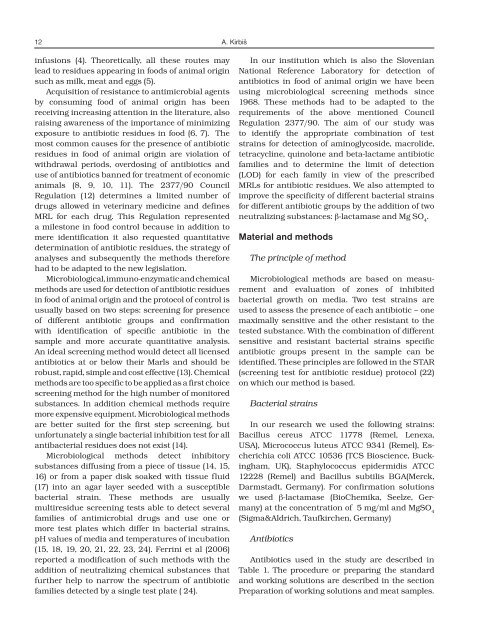Slov Vet Res 2007; 44 (1/2) - Slovenian veterinary research
Slov Vet Res 2007; 44 (1/2) - Slovenian veterinary research
Slov Vet Res 2007; 44 (1/2) - Slovenian veterinary research
Create successful ePaper yourself
Turn your PDF publications into a flip-book with our unique Google optimized e-Paper software.
12 A. Kirbiš<br />
infusions (4). Theoretically, all these routes may<br />
lead to residues appearing in foods of animal origin<br />
such as milk, meat and eggs (5).<br />
Acquisition of resistance to antimicrobial agents<br />
by consuming food of animal origin has been<br />
receiving increasing attention in the literature, also<br />
raising awareness of the importance of minimizing<br />
exposure to antibiotic residues in food (6, 7). The<br />
most common causes for the presence of antibiotic<br />
residues in food of animal origin are violation of<br />
withdrawal periods, overdosing of antibiotics and<br />
use of antibiotics banned for treatment of economic<br />
animals (8, 9, 10, 11). The 2377/90 Council<br />
Regulation (12) determines a limited number of<br />
drugs allowed in <strong>veterinary</strong> medicine and defines<br />
MRL for each drug. This Regulation represented<br />
a milestone in food control because in addition to<br />
mere identification it also requested quantitative<br />
determination of antibiotic residues, the strategy of<br />
analyses and subsequently the methods therefore<br />
had to be adapted to the new legislation.<br />
Microbiological, immuno-enzymatic and chemical<br />
methods are used for detection of antibiotic residues<br />
in food of animal origin and the protocol of control is<br />
usually based on two steps: screening for presence<br />
of different antibiotic groups and confirmation<br />
with identification of specific antibiotic in the<br />
sample and more accurate quantitative analysis.<br />
An ideal screening method would detect all licensed<br />
antibiotics at or below their Marls and should be<br />
robust, rapid, simple and cost effective (13). Chemical<br />
methods are too specific to be applied as a first choice<br />
screening method for the high number of monitored<br />
substances. In addition chemical methods require<br />
more expensive equipment. Microbiological methods<br />
are better suited for the first step screening, but<br />
unfortunately a single bacterial inhibition test for all<br />
antibacterial residues does not exist (14).<br />
Microbiological methods detect inhibitory<br />
substances diffusing from a piece of tissue (14, 15,<br />
16) or from a paper disk soaked with tissue fluid<br />
(17) into an agar layer seeded with a susceptible<br />
bacterial strain. These methods are usually<br />
multiresidue screening tests able to detect several<br />
families of antimicrobial drugs and use one or<br />
more test plates which differ in bacterial strains,<br />
pH values of media and temperatures of incubation<br />
(15, 18, 19, 20, 21, 22, 23, 24). Ferrini et al (2006)<br />
reported a modification of such methods with the<br />
addition of neutralizing chemical substances that<br />
further help to narrow the spectrum of antibiotic<br />
families detected by a single test plate ( 24).<br />
In our institution which is also the <strong>Slov</strong>enian<br />
National Reference Laboratory for detection of<br />
antibiotics in food of animal origin we have been<br />
using microbiological screening methods since<br />
1968. These methods had to be adapted to the<br />
requirements of the above mentioned Council<br />
Regulation 2377/90. The aim of our study was<br />
to identify the appropriate combination of test<br />
strains for detection of aminoglycoside, macrolide,<br />
tetracycline, quinolone and beta-lactame antibiotic<br />
families and to determine the limit of detection<br />
(LOD) for each family in view of the prescribed<br />
MRLs for antibiotic residues. We also attempted to<br />
improve the specificity of different bacterial strains<br />
for different antibiotic groups by the addition of two<br />
neutralizing substances: β-lactamase and Mg SO 4<br />
.<br />
Material and methods<br />
The principle of method<br />
Microbiological methods are based on measurement<br />
and evaluation of zones of inhibited<br />
bacterial growth on media. Two test strains are<br />
used to assess the presence of each antibiotic – one<br />
maximally sensitive and the other resistant to the<br />
tested substance. With the combination of different<br />
sensitive and resistant bacterial strains specific<br />
antibiotic groups present in the sample can be<br />
identified. These principles are followed in the STAR<br />
(screening test for antibiotic residue) protocol (22)<br />
on which our method is based.<br />
Bacterial strains<br />
In our <strong>research</strong> we used the following strains:<br />
Bacillus cereus ATCC 11778 (Remel, Lenexa,<br />
USA), Micrococcus luteus ATCC 9341 (Remel), Escherichia<br />
coli ATCC 10536 (TCS Bioscience, Buckingham,<br />
UK), Staphylococcus epidermidis ATCC<br />
12228 (Remel) and Bacillus subtilis BGA(Merck,<br />
Darmstadt, Germany). For confirmation solutions<br />
we used β-lactamase (BioChemika, Seelze, Germany)<br />
at the concentration of 5 mg/ml and MgSO 4<br />
(Sigma&Aldrich, Taufkirchen, Germany)<br />
Antibiotics<br />
Antibiotics used in the study are described in<br />
Table 1. The procedure or preparing the standard<br />
and working solutions are described in the section<br />
Preparation of working solutions and meat samples.
















